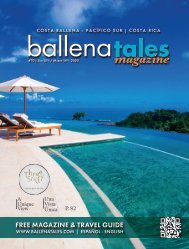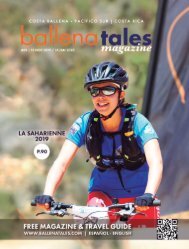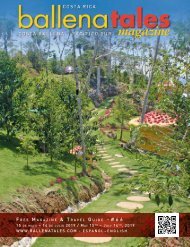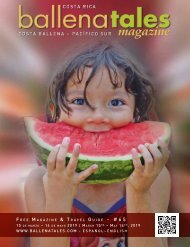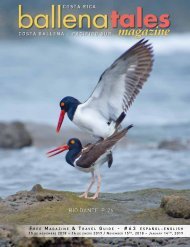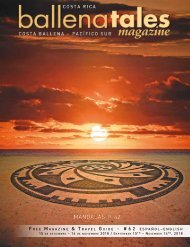South Pacific Costa Rica Travel Guide and Magazine #68
Visit the place where the forest meets the South Pacific Ocean in the Osa Canton. Visit Marino Ballena National Park the famous Whale’s Tail, with a length of about 2296 feet and a width of 820 feet, it is the world’s third-largest sandbank. During the low tide, you can walk to its very end. Ballena Tales is a Magazine & Travel Guide. Everything you need to know about Costa Ballena and Osa in the South Pacific of Costa Rica can be found here. From tides chart, discovering Local artists under Art & Culture to finding a Hotels in Osa, check out Tourism & Entertainment, we are here to lend you a hand. Discover the wonders of Costa Ballena and keep browsing to find all you’ll need to know about vacations in Costa Rica South Pacific Region.
Visit the place where the forest meets the South Pacific Ocean in the Osa Canton. Visit Marino Ballena National Park the famous Whale’s Tail, with a length of about 2296 feet and a width of 820 feet, it is the world’s third-largest sandbank. During the low tide, you can walk to its very end. Ballena Tales is a Magazine & Travel Guide. Everything you need to know about Costa Ballena and Osa in the South Pacific of Costa Rica can be found here. From tides chart, discovering Local artists under Art & Culture to finding a Hotels in Osa, check out Tourism & Entertainment, we are here to lend you a hand. Discover the wonders of Costa Ballena and keep browsing to find all you’ll need to know about vacations in Costa Rica South Pacific Region.
Create successful ePaper yourself
Turn your PDF publications into a flip-book with our unique Google optimized e-Paper software.
PÉREZ ZELEDÓN Y ALREDEDORES<br />
WILDLIFE -<br />
UNA CARA<br />
LLENA DE ESPINAS<br />
22<br />
AUTOR/AUTHOR: JACK EWING<br />
Es sorprendente lo poco que se sabe sobre el<br />
puercoespín mexicano (Coendou mexicanus),<br />
una de las diez especies que se encuentran<br />
en América y la única en <strong>Costa</strong> <strong>Rica</strong>. Al ser<br />
nocturnos, arbóreos y tímidos, rara vez se<br />
les ve. Viví en Hacienda Barú durante más de<br />
20 años antes de ver uno y me sorprendió lo<br />
pequeño que era en comparación con el que<br />
vi en las montañas de Colorado cu<strong>and</strong>o era<br />
adolescente. Recuerdo que ese era gr<strong>and</strong>e,<br />
lento y torpe. “Manténgase alejado de la<br />
cola”, advirtió mi padre. “Te golpeará con<br />
esas espinas, y lo lamentarás”. Continuó<br />
diciéndome que contrario a la creencia<br />
popular, los puercoespines no pueden arrojar<br />
sus espinas. Nuestros puercoespines en<br />
<strong>Costa</strong> Ballena son mucho más pequeños,<br />
pesan alrededor de 2 kg y sus colas son<br />
largas, peladas, musculosas y prensiles.<br />
Curvan hacia arriba, en lugar de hacia abajo<br />
como las de los monos y las martillas.<br />
El nombre puercoespín se deriva de las<br />
palabras “puerco” y “espinado”. Se dice<br />
que su carne sabe a carne de cerdo, pero no<br />
conozco a nadie que la haya probado. Los<br />
biólogos creen que son cazados por gr<strong>and</strong>es<br />
felinos y especulan que los jaguares y los<br />
pumas le dan la vuelta al puercoespín y abren<br />
el vientre, que está libre de espinas. Si hubiera<br />
espinas en el vientre, les costaría mucho a los<br />
bebes mamar. El biólogo Dr. Mike Mooring<br />
de la Talamanca Large Mammal Survey me<br />
aseguró que a menudo encuentran espinas<br />
en las heces de pumas. También me regaló<br />
una foto de un puma con espinas clavadas en<br />
la m<strong>and</strong>ibula.<br />
Varias fuentes afirman que el Coendou<br />
mexicanus se encuentra en todas partes de<br />
<strong>Costa</strong> <strong>Rica</strong>, excepto en la zona del Pacífico<br />
Sur, que incluye el Corredor Biológico Paso<br />
CONTACT: Jack Ewing – Hacienda Barú – see ad opposite page<br />
de la Danta, <strong>Costa</strong> Ballena y la Península de<br />
Osa. Esta afirmación es obviamente errónea.<br />
He hablado con gente mayor de toda la zona<br />
y descubrí que los puercoespines han estado<br />
aquí todo el tiempo que se pueda recordar.<br />
Curiosamente, el recuerdo predominante que<br />
todos tienen es el de un perro con la cara llena<br />
de espinas. Una señora recuerda también un<br />
chancho con la trompa llena de espinas.<br />
A NOSE<br />
FULL OF<br />
QUILLS<br />
It is surprising how little we know about the<br />
Mexican Porcupine (Coendou mexicanus),<br />
one of ten species found in the Americas, <strong>and</strong><br />
the only one in <strong>Costa</strong> <strong>Rica</strong>. Being nocturnal,<br />
arboreal, <strong>and</strong> secretive, they are seldom<br />
seen. I lived in Hacienda Barú for more than<br />
20 years before I saw one. I was surprised by<br />
how small it was compared to one I had seen<br />
in the mountains of Colorado as a teenager.<br />
I remember that one being big, slow, <strong>and</strong><br />
awkward. My dad warned me to stay clear of<br />
the quill covered tail. “He’ll whack you with<br />
those quills, <strong>and</strong> you’ll be sorry”. He also<br />
told me that it is not true that porcupines<br />
can throw their quills. Our porcupines in<br />
<strong>Costa</strong> Ballena are much smaller. They weigh<br />
only about 2 kg (4½ lbs), <strong>and</strong> their tails are<br />
long, bare, muscular, <strong>and</strong> prehensile, curling<br />
upward, rather than downward like those of<br />
monkeys <strong>and</strong> kinkajous.<br />
The name porcupine is derived from the<br />
words “pork” <strong>and</strong> “spined”. They say<br />
that their meat tastes like pork, but I don’t<br />
know anyone who has eaten one. Biologists<br />
believe that they are preyed upon by large<br />
cats, <strong>and</strong> speculate that jaguars <strong>and</strong> pumas<br />
flip the porcupine on its back <strong>and</strong> open the<br />
belly, which is free of quills. If there were<br />
quills on the belly, the babies would have a<br />
terrible time nursing. Dr. Mike Mooring of the<br />
Talamanca Large Mammal Survey assured<br />
me that they often find quills in puma scat.<br />
He also gave me a photo of a puma with<br />
quills stuck in the lower jaw.<br />
Several sources state that Coendou mexicanus<br />
is found everywhere in <strong>Costa</strong> <strong>Rica</strong> except the<br />
southwestern <strong>Pacific</strong> zone, which includes<br />
the Path of the Tapir Biological Corridor,<br />
<strong>Costa</strong> Ballena, <strong>and</strong> the Osa Peninsula. This<br />
information is erroneous. I have talked to oldtimers<br />
throughout the area. They confirmed<br />
that porcupines have been here as long<br />
as anyone can remember. Curiously, the<br />
predominant memory everyone has is that of<br />
a dog with a face full of quills.




